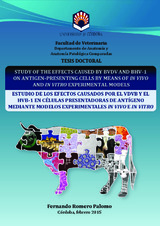Mostrar el registro sencillo del ítem
Study of the effects caused by BVDV and BHV-1 on antigen-presenting cells by means of in vivo and in vitro experimental models
| dc.contributor.advisor | Gómez-Villamandos, J.C. | |
| dc.contributor.advisor | Sánchez-Cordón, P.J. | |
| dc.contributor.advisor | Risalde, M. A. | |
| dc.contributor.author | Romero-Palomo, F. | |
| dc.date.accessioned | 2015-02-27T10:27:04Z | |
| dc.date.available | 2015-02-27T10:27:04Z | |
| dc.date.issued | 2015 | |
| dc.identifier.uri | http://hdl.handle.net/10396/12607 | |
| dc.description.abstract | The impairment of the immune system arisen during bovine viral diarrhea virus (BVDV) infections is one major paradigm of the immunology in the modern research of cattle diseases. In this sense, several efforts are being conducted to elucidate the complex mechanisms used by BVDV to evade the host immune response. Although BVDV is not a primary agent in the pathogenesis of bovine respiratory disease complex (BRDC), its suppressive effects on the host immune system can increase the risk of secondary infections, thus enhancing pulmonary colonization by other pathogens. Consequently, the general objective of this work was to contribute to the knowledge of the immunopathogenic strategies by which BVDV infections enhance the susceptibility to secondary infections, as those produced by bovine herpesvirus type 1 (BHV-1). Due to the important effects that viral pathogens can induce on the immune system, this work was firstly focused on a cell type of outstanding relevance for the immune system, the dendritic cells (DC), which are the most effective antigenpresenting cells (APC), and modulates both innate and adaptive immune responses. The absence of a solid literature detailing DC marker candidates for cattle gave rise to the first objective, focused on finding potential DC markers for the bovine species, standardize their immunohistochemical protocol and describe their histological distribution, in order to establish a basis for the study of DCs in diseased tissues (CHAPTER 1). For this purpose, paraffin wax-embedded tissues from 6 healthy Friesian calves were subjected to immunohistochemical studies and the most appropriate protocols were studied for each of the following primary antibodies: MHC-II, CD208, CD1b, CD205, CNA.42 and S100. Despite labeling other APCs, MHC-II expression was established as the most sensitive marker for detecting any DC of hematopoietic origin in bovine tissue sections. Both CNA.42 and anti-S100 antibodies stained stromal FDCs, but only the latter allowed for the identification of FDCs as isolated cells. Cells stained against... | es_ES |
| dc.description.abstract | El deterioro del sistema inmunológico que surge durante las infecciones con el virus de la diarrea vírica bovina (VDVB) es uno de los principales paradigmas de la inmunología en la investigación actual de las enfermedades del vacuno. En este sentido, se están llevando a cabo numerosos esfuerzos para dilucidar los complejos mecanismos utilizados por el VDVB para evadir la respuesta inmune del hospedador. Aunque el VDVB no es un agente primario en la patogénesis del complejo respiratorio bovino (CRB), sus efectos supresores sobre el sistema inmune del hospedador pueden aumentar el riesgo de infecciones secundarias, potenciando así la colonización pulmonar por otros patógenos. En consecuencia, el objetivo general de este trabajo fue contribuir al conocimiento de las estrategias inmunopatógenas mediante las cuales, infecciones con el VDVB aumentan la susceptibilidad a infecciones secundarias, como las producidos por el herpesvirus bovino tipo 1 (HVB-1). Debido a los importantes efectos que los patógenos virales pueden inducir sobre el sistema inmune, este trabajo se centró en primer lugar en un tipo de células de excepcional relevancia para el sistema inmune, las células dendríticas (CDs), que son las células presentadoras de antígeno (CPA) más eficaces y modulan las respuestas inmunitarias tanto innatas como adaptativas. La ausencia de una literatura sólida que detalle candidatos marcadores de CDs para bovino dio lugar al primer objetivo, centrado en encontrar marcadores potenciales de CDs para la especie bovina, estandarizar su protocolo inmunohistoquímico y describir su distribución histológica, con el fin de establecer una base para el estudio de las CDs en tejidos patológicos (CAPÍTULO 1). Para este propósito, tejidos incluidos en parafina de 6 terneros frisones sanos fueron sometidos a técnicas inmunohistoquímicas y se estudiaron los protocolos más apropiados para cada uno de los siguientes anticuerpos primarios: MHC-II, CD208, CD1b, CD205, CNA.42 y S100... | es_ES |
| dc.format.mimetype | application/pdf | es_ES |
| dc.language.iso | eng | es_ES |
| dc.publisher | Universidad de Córdoba, UCOPress | es_ES |
| dc.rights | https://creativecommons.org/licenses/by-nc-nd/4.0/ | es_ES |
| dc.subject | Bovine diarrhea virus | es_ES |
| dc.subject | Immunology | es_ES |
| dc.subject | Cattle | es_ES |
| dc.subject | Respiratory disease complex (BRDC) | es_ES |
| dc.subject | Bovine herpesvirus type 1 (BHV-1) | es_ES |
| dc.subject | Vaccine systems | es_ES |
| dc.subject | Virus de la diarrea vírica bovina (VDVB) | es_ES |
| dc.subject | Inmunología | es_ES |
| dc.subject | Ganado vacuno | es_ES |
| dc.subject | Complejo respiratorio bovino (CRB) | es_ES |
| dc.subject | Herpesvirus bovino tipo 1 (HVB-1) | es_ES |
| dc.subject | Sistemas de vacunación | es_ES |
| dc.subject | Vaccine systems | es_ES |
| dc.title | Study of the effects caused by BVDV and BHV-1 on antigen-presenting cells by means of in vivo and in vitro experimental models | es_ES |
| dc.title.alternative | Estudio de los efectos causados por el VDVB y el HVB en células presentadoras de antígeno mediante modelos experimentales in vivo e in vitro | es_ES |
| dc.type | info:eu-repo/semantics/doctoralThesis | es_ES |
| dc.rights.accessRights | info:eu-repo/semantics/openAccess | es_ES |

